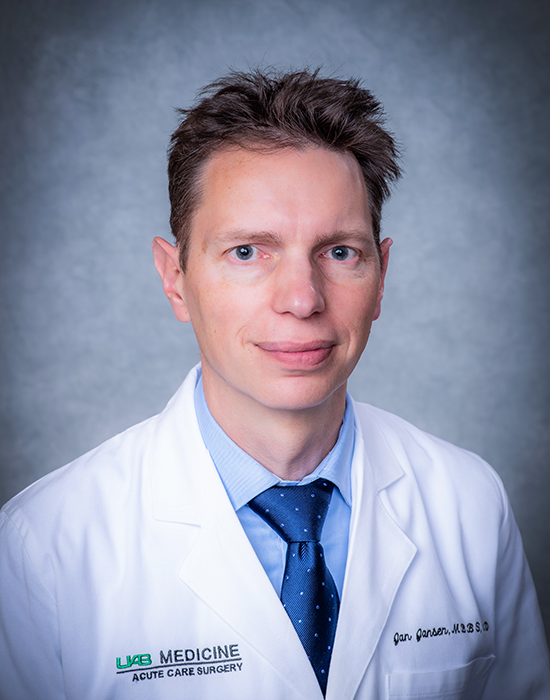Media contact: Bob Shepard
The Center for Injury Science Jan Jansen, MBBS, Ph.D, director of the Center for Injury Science. at the University of Alabama at Birmingham, together with the School of Public Health at the University of Texas Health Science Center at Houston, has been awarded $8.8 million by the National Institutes of Health to conduct a pivotal clinical trial in trauma patients.
Jan Jansen, MBBS, Ph.D, director of the Center for Injury Science. at the University of Alabama at Birmingham, together with the School of Public Health at the University of Texas Health Science Center at Houston, has been awarded $8.8 million by the National Institutes of Health to conduct a pivotal clinical trial in trauma patients.
The Trauma Resuscitation with Group O Whole Blood or Products, or TROOP trial, will compare two resuscitation strategies — one using whole blood, the other using component therapy — in trauma patients predicted to require large-volume blood transfusions.
Bleeding is the most common cause of preventable death following injury. The traditional approach for treating injured patients who are bleeding is to transfuse multiple separate units of red blood cells, plasma and platelets — known as component therapy. However, recent evidence from military and civilian medicine suggests outcomes are better when patients receive whole blood, instead of previously separated blood products.
TROOP is the first large-scale clinical trial evaluating whole blood in injured patients. The design of the trial was supported by a U34 planning grant from the National Heart, Lung and Blood Institute. The TROOP trial’s Clinical Coordinating Center is based in the Center for Injury Science at UAB, and the Data Coordinating Center is based in the School of Public Health, at UT Health.
TROOP will demonstrate whether hemorrhaging trauma patients who receive whole blood have improved mortality compared to those who receive component therapy. If shown to be effective, treatment with whole blood could transform the standard of care for bleeding trauma patients and save many lives. The trial will be conducted in 12 leading Level I trauma centers in the United States and will include 1,100 patients.
The CCC’s principal investigators are Jan Jansen, MBBS, Ph.D., the director of CIS, and a professor in the Division of Trauma and Acute Care Surgery; John Holcomb, M.D., a professor in the division and CIS senior scientist; and Henry Wang, M.D., professor of emergency medicine and vice chair of Research at the Ohio State University. Shannon Stephens, executive director of CIS, is the program manager.
Since trauma patients usually cannot give informed consent, the trial will be an Exception-From-Informed-Consent study. CIS will meet federal regulations by using innovative, media-based methods pioneered by Stephens for educating and engaging with communities across the United States. UAB is the only institution in the U.S. to have led interactive, media-based community consultations for multi-center trials.
The Center for Injury Science was founded in 1999 and conducts research to improve trauma care. The mission of CIS is to promote injury prevention and to improve outcomes from injury at all stages of care, from the prehospital setting through to resuscitation, acute care and rehabilitation. Clinicians from many specialties — including trauma surgeons, emergency medicine physicians, anesthesiologists, intensivists and rehabilitation specialists — work closely with epidemiologists, basic scientists, biostatisticians, health economists, health psychologists and methodologists.
The TROOP trial is run by the center’s Clinical Trials Unit, which is also conducting the Trauma and Prothrombin complex concentrate trial.